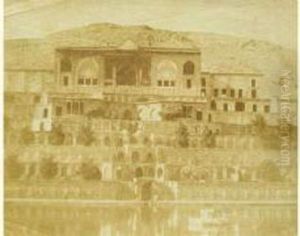Luigi Pesce Paintings
Luigi Pesce was an Italian photographer, known for his pioneering work in documenting the landscapes, monuments, and people of the Middle East, particularly in what is now Iran. Born in Naples, Italy, in 1827, Pesce embarked on a career that would see him become one of the earliest photographers to explore the artistic and documentary potential of photography beyond the European continent.
After receiving a medical degree, Pesce joined the Neapolitan army but soon left Italy due to the political upheavals of the time. His journey led him to the Middle East, where he became fascinated with the region's architecture, culture, and history. Settling in Iran in the 1850s, he was appointed as the official photographer by the Qajar court, a position that gave him unprecedented access to capture the country's landscapes, historical sites, and daily life during a period of significant change.
Pesce's work is characterized by its meticulous attention to detail and its pioneering use of photography as a means of cultural documentation. His photographs offer invaluable insights into the architectural heritage of Iran, including early images of Persepolis, the Golestan Palace, and other important sites. Beyond architecture, his portraits of individuals from various social standings provide a rare glimpse into the lives of 19th-century Iranians, from royals and dignitaries to ordinary citizens.
Despite his significant contributions to the field of photography and the historical record of Iran, Luigi Pesce remains a somewhat elusive figure in art history. His work, however, continues to be studied and appreciated for its artistic quality and documentary value. Pesce's photographs not only serve as a bridge connecting past and present but also as a testament to the early use of photography in understanding and preserving cultural heritage. He died in 1864, leaving behind a legacy that would inspire future generations of photographers and historians alike to explore the rich tapestry of human civilization through the lens of a camera.
